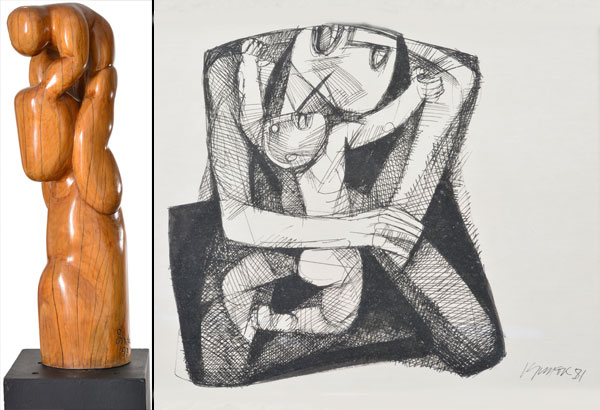Rekindling old identities, searching for new ones
MANILA, Philippines - Anita Magsaysay-Ho saw the passing of a century of form and content in the visual arts. The birth of modernism didn’t come with this list of names, but it flourished with the mentorship of triumvirs Victorio Edades, Carlos “Botong” Francisco and Galo Ocampo, to mention a few names.
Thus, in this “Milestone” exhibit at Liongoren Gallery, we discern two crisscrossing trajectories within Philippine modern art.
The dual themes of traditionalism and modernism provide a lively, dynamic dialogue from the rich spectrum of styles of these artists that span aesthetic poles. All of which can be appreciated from within a wide reference of semiotic, iconic, contextual and evaluative viewpoints. To quote Clement Greenberg, “Each art had to determine through the operations peculiar to itself, the effects peculiar and exclusive to itself.”
The first trajectory is defined by the prominent artists who in their themes and subjects refused to conform to the progressively urban spirit of Manila. These names include the lone woman of the 13 Moderns: Magsaysay-Ho, considered “the female Amorsolo.”
During the early 1940s, Magsaysay-Ho’s works showed the influence of Amorsolo in choice of subjects and in treatment of light and color. However, these works had very modernist tendencies, such as the use of expressive distortion and concern for design and rhythm in her otherwise “representational paintings.”
Of the other names who kept with the folk genre as subject and theme, the exemplar was Jose Blanco. His bucolic style appears to reflect the conditions of the country while resisting being absorbed by the strong personality of his longtime mentor and fellow Angono resident Carlos “Botong” Francisco. Mario Parial’s subjects were of the folk genre, which was the forte of his mentors Vicente Manansala, Antonio Austria and Botong.
 “Father & Son” by Inday Cadapan (left); A pen and ink artwork by Ang Kiukok (right)
“Father & Son” by Inday Cadapan (left); A pen and ink artwork by Ang Kiukok (right) Lino Severino and Nik Ricio both looked further back to the ephemeral reality of the past. Severino found inspiration from the antique facades in his town, and visually dissolving them into ephemeral memory. His “Vanishing Scene” series became increasingly abstract, propelled by the modernist impulse, and steeped in deep hues of blue and brown. Ricio recaptured bygone eras through graphic design.
Abdul Mari Imao was firmly grounded in two strong traditions: the Muslim artistic tradition of the south, particularly the Tausug ukkil design (Maranao okir) design system, and the Western modernist tradition, particularly that of the School of Paris in its many permutations. He explored the magnificence of the southern groups in his own contemporary idiom, even combining ornament and calligraphy to create sculptural variations of the name of Allah.
The young Don Salubayba connected myth and history rekindling themes that inevitably are made into archetypal instruments of identity.
The other trajectory consists of artists whose themes and subjects have eschewed conservative acceptance, or who worked beyond comfort zones.
Ang Kiukok’s violent visual metaphors on the human condition; Inday Cadapan’s perpetually agitated portrayal of women reflecting the various dilemmas besieging the modern Filipina (from prostitution to political issues); and Jerry Araos’ ideologically informed litanies against dehumanization confronted urban issues outside or within the definition of protest art.
These artists broke past the commonplace, through limits and conventions: Dean Honrado Fernandez’ sculptural explorations of art and the architectonic, and Sid Hildawa’s dissonant rediscovery of the decorative.
Raul Piedra’s remotely silent explorations of textures deleted subject matter altogether. Its aim was to create nonobjective art, or abstraction for abstraction’s sake.
Lee Aguinaldo may arguably be the most innovative among the non-traditional themed artists, what with the techniques that he developed including “flicking” paint from a palette knife on the canvas; “galumphing,” which incorporated a few pop images and was largely influenced by Jackson Pollock; and for his hard-edge minimalist style which influenced a new generation of abstractionists in the 1960s.
When enfant terrible poet and painter David Cortes Medalla left the Philippines for Europe in the 1960s, it fell to Roberto Chabet to keep the avant-garde fires burning. His position as studio arts professor in UP from 1969 to 1971 enabled him to pursue this mission.
The uncompromising aim of Conceptual Art, which goes way back to the late Sixties and early Seventies, has been both its strength and the cause of intense criticism. Conceptualism has also led to today’s “anti aesthetic” tendencies that have been used to contest definitions of art given by bodies that disseminate art.
This tribute ends with Federico Aguilar Alcuaz who can be placed at the fulcrum of both trajectories. As a pioneering abstractionist, Alcuaz had much in common with many other Filipino abstractionists of his generation because many of them shared a traditional background. Thus, like a refrain, there’s Alice Guillermo’s description of Alcuaz’ hotel suite: “And then there are always the two rooms, one for the abstracts, the other for the figurative…”
These artists have conveyed new ways of seeing through all the various ever-evolving techniques and processes of image-making. Never before had there been so many ideas about what art could be or how it could be made; never had new art been the subject of such impassioned controversy. Inevitably, all that had seemed startling or threatening came to look normal, even classical, within a few decades.
In the end, the new may have even lost the power to shock.
* * *
Liongoren Gallery pays tribute to these late eminent artists with a group show that is on view from Jan. 12 to Feb. 11. The gallery is at 111 New York-Stanford Streets Cubao, Quezon City. For inquiries call 912-4319 or 439-3962, 964-3496.



















